Related Research Articles

Septimia Zenobia was a third-century queen of the Palmyrene Empire in Syria. Many legends surround her ancestry; she was probably not a commoner and she married the ruler of the city, Odaenathus. Her husband became king in 260, elevating Palmyra to supreme power in the Near East by defeating the Sasanian Empire of Persia and stabilizing the Roman East. After Odaenathus' assassination, Zenobia became the regent of her son Vaballathus and held de facto power throughout his reign.
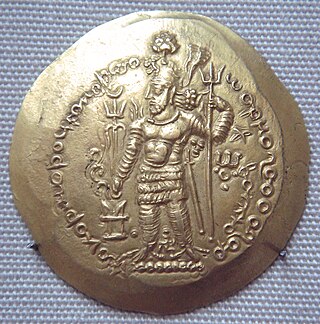
Year 272 (CCLXXII) was a leap year starting on Monday of the Julian calendar. At the time, it was known as the Year of the Consulship of Postumius and Veldumnianus. The denomination 272 for this year has been used since the early medieval period, when the Anno Domini calendar era became the prevalent method in Europe for naming years.
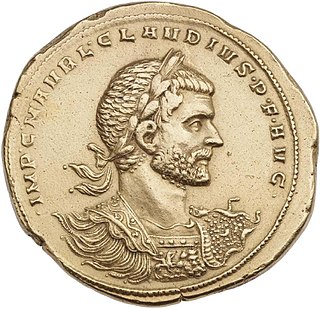
Marcus Aurelius Claudius "Gothicus", also known as Claudius II, was Roman emperor from 268 to 270. During his reign he fought successfully against the Alemanni and decisively defeated the Goths at the Battle of Naissus. He died after succumbing to a "pestilence", possibly the Plague of Cyprian that had ravaged the provinces of the Empire.

Septimius Odaenathus was the founder king (Mlk) of the Palmyrene Kingdom who ruled from Palmyra, Syria. He elevated the status of his kingdom from a regional center subordinate to Rome into a formidable state in the Near East. Odaenathus was born into an aristocratic Palmyrene family that had received Roman citizenship in the 190s under the Severan dynasty. He was the son of Hairan, the descendant of Nasor. The circumstances surrounding his rise are ambiguous; he became the lord (ras) of the city, a position created for him, as early as the 240s and by 258, he was styled a consularis, indicating a high status in the Roman Empire.
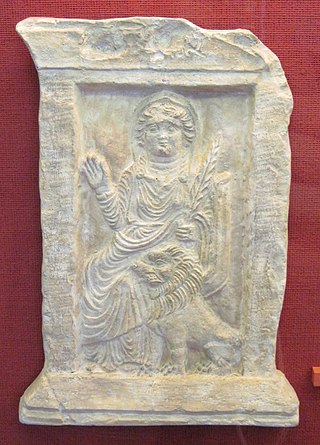
al-Lat, also spelled Allat, Allatu and Alilat, is a pre-Islamic Arabian goddess worshipped under various associations throughout the entire Arabian Peninsula, including Mecca where she was worshipped alongside Manat and al-'Uzza as one of the daughters of Allah. The word Allat or Elat has been used to refer to various goddesses in the ancient Near East, including the goddess Asherah-Athirat.

Septimius Vaballathus was emperor of the Palmyrene Empire centred at Palmyra in the region of Syria. He came to power as a child under his regent mother Zenobia, who led a revolt against the Roman Empire and formed the independent Palmyrene Empire.

The Battle of Emesa was fought in 272 between the Roman armies led by their emperor Aurelian and the Palmyrene forces led by their queen, Zenobia and general Zabdas.

The Battle of Immae was fought in 272 between the Roman army of Emperor Aurelian, and the armies of the Palmyrene Empire, whose leader, Queen Zenobia, had usurped Roman control over the eastern provinces.
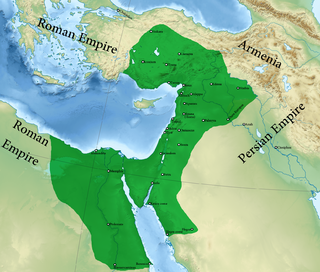
The Palmyrene Empire was a short-lived breakaway state from the Roman Empire resulting from the Crisis of the Third Century. Named after its capital city, Palmyra, it encompassed the Roman provinces of Syria Palaestina, Arabia Petraea, and Egypt, as well as large parts of Asia Minor.
Zabdas was a 3rd-century Syrian general who led the forces of Queen Zenobia of Palmyra during her rule as regent of her son Vaballathus and her subsequent rebellion against the Roman Emperor under the short-lived independent Palmyrene Empire. He led Palmyra's expeditions in the middle east which included annexing territory spanning from Roman Egypt to Asia Minor.
Middle East empires have existed in the Middle East region at various periods between 3000 BCE and 1924 CE; they have been instrumental in the spreading of ideas, technology, and religions within Middle East territories and to outlying territories. Since the 7th century CE, all Middle East empires, with the exception of the Byzantine Empire, was islamic and some of them claiming the titles of Islamic caliphate. The last major empire based in the region was the Ottoman Empire.
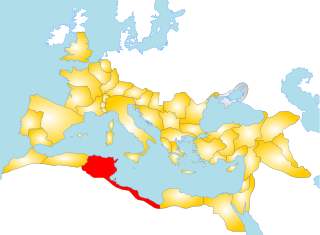
Tenagino Probus was a Roman soldier and procuratorial official whose career reached its peak at the end of the sixth decade of the third century AD. A poverty of primary sources means that nothing is known for certain of his origins or early career. However, in later years he served successively as Praeses (governor) of the province of Numidia and of Egypt,. These were both very senior procuratorial offices, the latter in particular traditionally considered one of the pinnacles of an equestrian career. In these roles he exercised military skills in addition to administrative ones; as Praefectus Aegypti he led military operations outside his province. He died resisting the invasion of Egypt by the forces of Zenobia of Palmyra in the troubled interregnum between Emperors Claudius II and Aurelian.
The Siege of Tyana occurred in 272 CE. The forces of the Roman Emperor Aurelian were seeking to conquer the Palmyrene Empire.
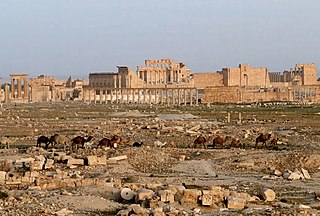
Palmyra is an ancient city in present-day Homs Governorate, Syria. Archaeological finds date back to the Neolithic period, and documents first mention the city in the early second millennium BC. Palmyra changed hands on a number of occasions between different empires before becoming a subject of the Roman Empire in the first century AD.
Septimius Orodes was a Palmyrene official and a viceroy for king Odaenathus of Palmyra. He was given the surname Septimius by his monarch.
Septimius Haddudan was a 3rd-century Palmyrene official, the only known Palmyrene senator other than Odaenathus, and a priest and symposiarch of the god Bel, who is known to have opposed the rule of Queen Zenobia of Palmyra and aided the Roman Empire during their wars against the queen.

The sack of Bostra occurred around the spring of 270 AD when Queen Zenobia of Palmyra sent her general, Zabdas, to Bostra, the capital of Arabia Petraea, to subjugate the Tanukhids who were challenging Palmyrene authority.

The Palmyrene invasion of Egypt occurred in the summer, or possibly in October, of 270 AD when the forces of Queen Zenobia of Palmyra, led by her general Zabdas and aided by an Egyptian general named Timagenes, invaded and subsequently annexed Egypt, which was under control of the Roman Empire at the time.

The Temple of the Gadde is a temple in the modern-day Syrian city of Dura-Europos, located near the agora. It contained reliefs dedicated to the protective deities of Dura-Europos and the nearby city of Palmyra, after whom the temple was named by its excavators. The temple was excavated between 1934 and January 1936 by the French/American expedition of Yale University, led by Michael Rostovtzeff.

Odaenathus, the king of Palmyra from 260 to 267 CE, has been identified by modern scholars as the subject of sculptures, seal impressions, and mosaic pieces. His city was part of the Roman Empire, and he came to dominate the Roman East when in 260 he defeated Shapur I, the Sasanian emperor of Persia, who had invaded the Roman Empire. Odaenathus besieged the Sasanian capital Ctesiphon in 263, and although the city did not fall, the campaign led to a full restoration of Roman provinces taken by Shapur I. In the aftermath of his Persian war, Odaenathus assumed the title King of Kings, which was a challenge to the Persian monarch's claims of authority in the region. Odaenathus ruled the Roman East unopposed with imperial consent. In 267, he was assassinated alongside his eldest son Herodianus while conducting a campaign against Germanic raiders in Bithynia; he was succeeded by his son Vaballathus under the regency of the widow queen Zenobia.
References
- 1 2 3 4 5 Bryce, Trevor (2014). Ancient Syria: A Three Thousand Year History. p. 297. ISBN 9780199646678.
- ↑ Hillers, Delbert R. (2005). A Journey to Palmyra: Collected Essays to Remember Delbert R. Hillers. p. 297. ISBN 9789004124189.